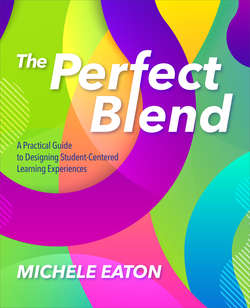Читать книгу The Perfect Blend - Michele Eaton - Страница 32
На сайте Литреса книга снята с продажи.
Personalized Learning in the Blended Classroom
ОглавлениеLet’s be clear from the beginning: Simply adding a component of online learning into your classroom will not guarantee the transformation of your students’ classroom experience. That said, however, you will see one component in almost all successful blended learning implementations. You will see student agency.
Student agency is present when learning is meaningful, relevant, and driven by a student’s personal interests. Students who have true ownership of their learning take an active role in their education by experiencing opportunities for voice and choice in the classroom. Students, not the teacher, are the center of the classroom, each deciding what they are going to learn, how they are going to learn it, and/or how they can demonstrate mastery of what they have learned.
Blended learning creates an environment that allows students some autonomy over their learning. By personalizing the learning experience, we can increase student engagement, provide workable and manageable solutions to individualize learning, and help students learn what it means to be successful self-regulators. In turn, we also help increase student agency.
You would be hard-pressed to find a teacher who does not believe in the basic premise of personalized learning, the belief that helping students take ownership of their learning has a positive effect on the students’ classroom experience. There might be disagreements on various approaches or implementations, but ultimately, we all want to help students develop into lifelong learners that can identify and solve problems.
It is not an issue of whether teachers want this for the classroom. The reality is that it is hard to wrap our heads around what personalized learning looks like in a full classroom of students with diverse strengths and needs, a strict state- or district-mandated curriculum, and an already substantial workload placed on the teacher. Additionally, if you are trying to achieve more than very basic differentiation in lessons without expensive adaptive software, it can feel almost insurmountable.
I am here to tell you that we can break down and implement personalized learning in a way that is realistic and feasible for the modern classroom. You can do it with adaptive software, or you can do it in an environment with access to just a few devices and completely teacher-created content. The important thing to remember is what is at the heart of personalized learning: students. It is not about going 1:1 or devices or expensive software. Personalization is about creating a student-centered learning environment.
In almost any discussion of student agency and personalized learning, someone will eventually mention differentiation. Although the terms personalization and differentiation are often used interchangeably, they actually represent two very different types of instruction. I like to think about one key difference, and that is who is in charge of changes made to a learning activity. In differentiation, the teacher makes adjustments and changes in the learning activity to help a student be successful. In personalized learning, students make adjustments and changes in the learning activity to help themselves be successful.
To take that one step further, blended learning is not necessarily personalized, and vice versa. However, the two can (and I think should) go hand in hand. Blended learning can be the environment that makes personalization possible and effective. We can design blended experiences with student agency in mind.
I am not advocating that we get rid of differentiation, however. We should all be slow to discard strategies and structures that work in exchange for the latest and greatest buzzword. Finding the appropriate time to differentiate while finding ways for students to have some autonomy in those decisions is all part of the art of teaching. As you will learn in Chapters 3 and 4, some aspects of blended learning can lend themselves to creating opportunities for differentiation, while others are more suited for personalization.
